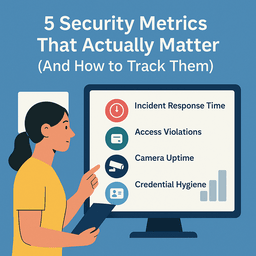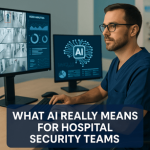
When it comes to physical security, most organizations focus on the tools: cameras, badges, alarms, gates. But what often gets overlooked is this simple truth:
🔍 You can’t improve what you don’t measure.
Without tracking meaningful security performance metrics, it’s impossible to know if your systems and protocols are doing their job—or where you might be vulnerable.
At SSP, we believe every facility—whether it’s a school, warehouse, or commercial office—deserves security systems that don't just exist, but perform. Here’s how to measure what really matters.
k
k
Why Measuring Security Performance Matters
Imagine installing hundreds of cameras, dozens of card readers, and state-of-the-art alarms—and still missing a threat because no one noticed a broken process.
Security isn’t just about equipment—it’s about outcomes.
Metrics help you:
-
Justify your security budget
-
Spot early warning signs
-
Optimize staffing and response plans
-
Strengthen compliance for audits or inspections
Bottom line: Good security is measurable security.
k
k
The 5 Security Performance Metrics You Should Track
1. 🚨 Incident Response Time
Definition: The time between when an alarm, access violation, or suspicious activity is detected—and when staff responds.
Why it matters:
-
Faster responses reduce losses, injuries, and disruptions.
-
Response time is a strong indicator of staff readiness and system design effectiveness.
How to track it:
-
Use timestamps from alarm logs, access violations, or security dispatch calls.
-
Aim for continuous improvement by analyzing slow responses for root causes.
k
k
2. 🚪 Unauthorized Access Attempts
Definition: The number of times individuals try (and fail) to access secured areas.
Why it matters:
-
Spikes may indicate internal policy issues—or attempted breaches.
-
Tracking helps fine-tune access permissions and visitor management systems.
How to track it:
-
Leverage your access control system's event reports.
-
Set alerts for high-risk doors or after-hours violations.
k
k
3. 🎥 Camera Uptime and Video Quality
Definition: The percentage of time surveillance cameras are functional and recording clear footage.
Why it matters:
-
A non-functional camera during an incident is worse than no camera at all.
-
Blurry or incomplete footage undermines investigations and insurance claims.
How to track it:
-
Implement health monitoring tools that auto-report offline cameras.
-
Conduct monthly spot-checks for video quality.
k
k
4. 🔒 Access Control Credential Hygiene
Definition: The number of active users in your system who no longer need access.
Why it matters:
-
"Credential creep" happens when former employees, vendors, or students retain active badges—creating silent vulnerabilities.
How to track it:
-
Schedule quarterly audits of your credential list.
-
Cross-check against HR rosters or vendor contracts.
k
k
5. 📝 Security Policy Compliance Rate
Definition: How often employees, visitors, and contractors follow established security protocols.
Why it matters:
-
Technology is only as effective as the people using it correctly.
-
Compliance gaps often reveal training needs or unclear procedures.
How to track it:
-
Conduct periodic audits (e.g., are doors being propped open? Are badges worn?)
-
Include compliance observations in monthly facility reviews.
k
k
Bonus Metric: Staff Security Awareness Level
While harder to quantify, staff awareness impacts every other metric.
Use short quarterly surveys or "mystery checks" to gauge:
-
Who knows emergency procedures?
-
Who recognizes tailgating risks?
-
Who properly reports security concerns?
j
j
How SSP Helps You Turn Metrics Into Improvements
At SSP, we design security solutions that don’t just defend your facility—they deliver real-world results.
We help clients:
-
Set up automated reporting from access control and video platforms
-
Train internal teams on what to track (and what to ignore)
-
Conduct quarterly performance reviews to strengthen weak points
Because real security isn’t just installed—it’s measured, maintained, and improved.


